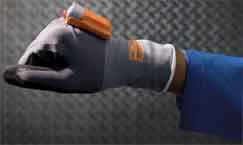Below are three of the top stories in automated data collection, RFID and the Internet of Things in recent weeks.
Will New Codes and Technology Push the UPC Code Aside in Retail?
A new blog post from the analysts over at VDC Research says leading retailers are actively looking at several types of newer age bar codes versus the traditional UPC/GTIN at point of sale.
Those are: Digimarc Watermarking, QR Code, and Digital Image Recognition.
Supply Chain Digest Says... |
 |
| A smart idea for those who want to arm-waving magic without the chip insertion. |
 |
What do you say? |
| Click here to send us your comments |
 |
| Click here to see reader feedback |
|
|
VDC says approximately 28% of retailers are extremely familiar with Digimarc's Invisible Barcode, citing that the faster throughput at checkout and the improved packaging design were the primary benefits for applying this particular scan to items at the POS.
With the Digimarc, price, item number and other important data can be captured instantly through camera scanners and some special software. Not only is this "invisible barcode" more effective at empowering merchants to participate in dynamic pricing, but also allows for a greater level of transparency between the consumer and the firm, thus lowering the transaction costs associated with the purchase.
Digimarc accomplishes this by allowing factors about the product - such as nutritional information, and customer reviews - to be readily accessible through mobile devices. The biggest challenge with Digimarc, VDC says, is that for its benefits to be fully realized at the POS, all items would need to be encoded: a factor that can be quite expensive to apply given the need for new image-based scanners to process the codes and supplier cooperation.
QR Code is a matrix two-dimensional symbology able to encode thousands of characters in a single symbol. QR Codes have become especially prevalent in mobile payment systems. A standardized approach seen in apps like WeChat and Alipay, QR Codes have opened markets in countries where access to traditional banking is limited, granted financial empowerment to both merchants and consumers alike in the payment process, and allowed consumers to review rates and potential deals in real time on any device.
Although traditional barcodes are much more simplistic - both easier to read and make - VDC says the QR Code is able to leverage the power of mobile phones and form a direct relationship with the business's customers. A virtual punch-card able to measure the frequency and "loyalty" of each client, the QR Code allows businesses to be highly CRM-focused and relay a substantial amount of information back to the consumer.
Finally, computer vision using Digital Image Recognition is also predicted to move to the forefront of POS technologies by the year 2021. This will not only enable retailers develop cashierless stores, but also the ability to identify items with pictures rather than barcodes.
Such 'grab-and-go' technology can reduce inventory losses, automatically capture audits on price tags, and notify attendants of all suspicious activities that may occur in-store.
VDC says that "Ideally this technology would be able to remove human intervention - and subsequently remove human error - from the customer shopping experience. Using a combination of real-time analytics and cameras, Digital Image Recognition frees workers from the mundane and outdated operational process of tracking and manually ensuring complete compliance with all merchandizing standards and safety regulations. "
VCD adds that its research shows that "consumer expectations are pressuring retailers to drive change to their operations - in particular the POS process – and to how they digitally engage with customers."
Might the near 50 year reign of the UPC code may be over soon?
A Fashion Alternative to Full RFID Implants
SCDigest has now reported a number of times on the trend of sorts for people to have RFID tags implanted in their bodies, usually between the thumb and for finger, to automate with the wave of an arm activities such as opening garage doors, turning on computers, using copy machines at the office, and other tasks.
Just two week ago, we told the story of software engineer "Annie DD," who had a chip for her Telsa card – after dissolving the car using acetone to get at the chip – implanted in her forearm so she could start the electronic car with an arm wave.
(See More Below)
|
CATEGORY SPONSOR: SOFTEON |
|
|
| |
|
|
This so called "bio-hacking" or "transhumanism" may not be for everyone, of course. Annie DD couldn't find a doctor to implant the chip, so she relied on a tattoo artist instead, apparently successfully.
But now a smart idea for those who want to arm-waving magic without the chip insertion.
 A woman only identified on social media as "Becky" has designed an artistic ring that includes an RFID tag, as seen in the image nearby. A woman only identified on social media as "Becky" has designed an artistic ring that includes an RFID tag, as seen in the image nearby.
In addition to eliminating the need implant technology under your epidermis, there are a few other advantages: tags as easy as changing rings, example. You can also easily loan your ring to someone just as you might give them keys to your door.
The ring is something close to two rings connected by slender pillars. Two of the three pillars are metal, but the third is the RFID tag.
Becky even has a free online jewelry class over on Instructables web site if you want to build your own RFID ring. Could make a great stocking stuffer for this Holiday season.
Barcode Scanning Glove Maker ProGlove get $40 Million Investment
ProGlove, a German-based startup developing wireless gloves with built-in barcode scanners and gesture-sensing features, recently announced that it's secured a $40 million investment from private equity investor Summit Partners.
The ProGloves (see image nearby) come in a standard version for picking, assembly, packing, and staging tasks, but also include a version with palm and index trigger that can be worn with a free hand or in combination with different glove types. All can be customized via a configuration tool that's optimized for smartphones and tablets, and they transmit data over a dedicated radio connection that can be freely selected from 70 channels.
 ProGlove's secret sauce is the Mark 2, a compact module that fastens to the back of its gloves and pairs with tablets, smartwatches, wearable computers, and other devices over Bluetooth Low Energy from up to 150 centimeters away. It provides feedback in the form of adjustable acoustic signals, vibration, and LEDs on the back of the hand, and it lasts for up to 15 hours on a charge. ProGlove's secret sauce is the Mark 2, a compact module that fastens to the back of its gloves and pairs with tablets, smartwatches, wearable computers, and other devices over Bluetooth Low Energy from up to 150 centimeters away. It provides feedback in the form of adjustable acoustic signals, vibration, and LEDs on the back of the hand, and it lasts for up to 15 hours on a charge.
The Mark 2 slides into a dedicated docking station for recharging. ProGlove says its scanner unit can reduce scanning time by up to 4 seconds per scan, representing an improvement in scanning efficiency of as much as 50%. It also claims productivity is improved by its complementary software solutions, which give glove wearers feedback on tasks performed to cut down on mistakes, improve quality, and provide data for future decisions.
Any reaction to the stories in this week' roundup? Let us know your thoughts at the Feedback section below.
Your Comments/Feedback
|